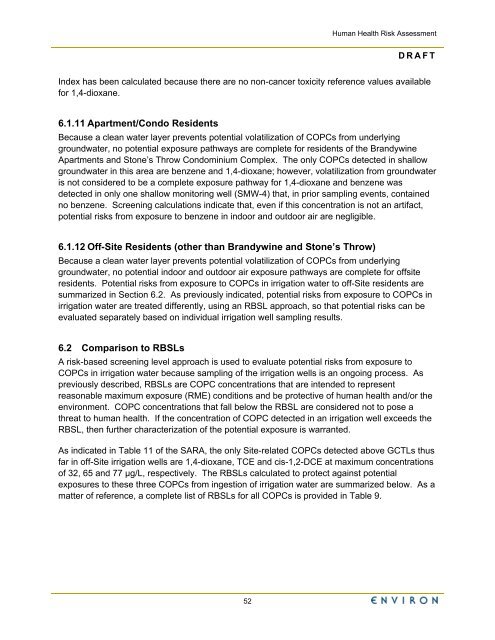Human Health Risk Assessment - Raytheon
Human Health Risk Assessment - Raytheon
Human Health Risk Assessment - Raytheon
Create successful ePaper yourself
Turn your PDF publications into a flip-book with our unique Google optimized e-Paper software.
52<br />
<strong>Human</strong> <strong>Health</strong> <strong>Risk</strong> <strong>Assessment</strong><br />
DRAFT<br />
Index has been calculated because there are no non-cancer toxicity reference values available<br />
for 1,4-dioxane.<br />
6.1.11 Apartment/Condo Residents<br />
Because a clean water layer prevents potential volatilization of COPCs from underlying<br />
groundwater, no potential exposure pathways are complete for residents of the Brandywine<br />
Apartments and Stone’s Throw Condominium Complex. The only COPCs detected in shallow<br />
groundwater in this area are benzene and 1,4-dioxane; however, volatilization from groundwater<br />
is not considered to be a complete exposure pathway for 1,4-dioxane and benzene was<br />
detected in only one shallow monitoring well (SMW-4) that, in prior sampling events, contained<br />
no benzene. Screening calculations indicate that, even if this concentration is not an artifact,<br />
potential risks from exposure to benzene in indoor and outdoor air are negligible.<br />
6.1.12 Off-Site Residents (other than Brandywine and Stone’s Throw)<br />
Because a clean water layer prevents potential volatilization of COPCs from underlying<br />
groundwater, no potential indoor and outdoor air exposure pathways are complete for offsite<br />
residents. Potential risks from exposure to COPCs in irrigation water to off-Site residents are<br />
summarized in Section 6.2. As previously indicated, potential risks from exposure to COPCs in<br />
irrigation water are treated differently, using an RBSL approach, so that potential risks can be<br />
evaluated separately based on individual irrigation well sampling results.<br />
6.2 Comparison to RBSLs<br />
A risk-based screening level approach is used to evaluate potential risks from exposure to<br />
COPCs in irrigation water because sampling of the irrigation wells is an ongoing process. As<br />
previously described, RBSLs are COPC concentrations that are intended to represent<br />
reasonable maximum exposure (RME) conditions and be protective of human health and/or the<br />
environment. COPC concentrations that fall below the RBSL are considered not to pose a<br />
threat to human health. If the concentration of COPC detected in an irrigation well exceeds the<br />
RBSL, then further characterization of the potential exposure is warranted.<br />
As indicated in Table 11 of the SARA, the only Site-related COPCs detected above GCTLs thus<br />
far in off-Site irrigation wells are 1,4-dioxane, TCE and cis-1,2-DCE at maximum concentrations<br />
of 32, 65 and 77 µg/L, respectively. The RBSLs calculated to protect against potential<br />
exposures to these three COPCs from ingestion of irrigation water are summarized below. As a<br />
matter of reference, a complete list of RBSLs for all COPCs is provided in Table 9.

















